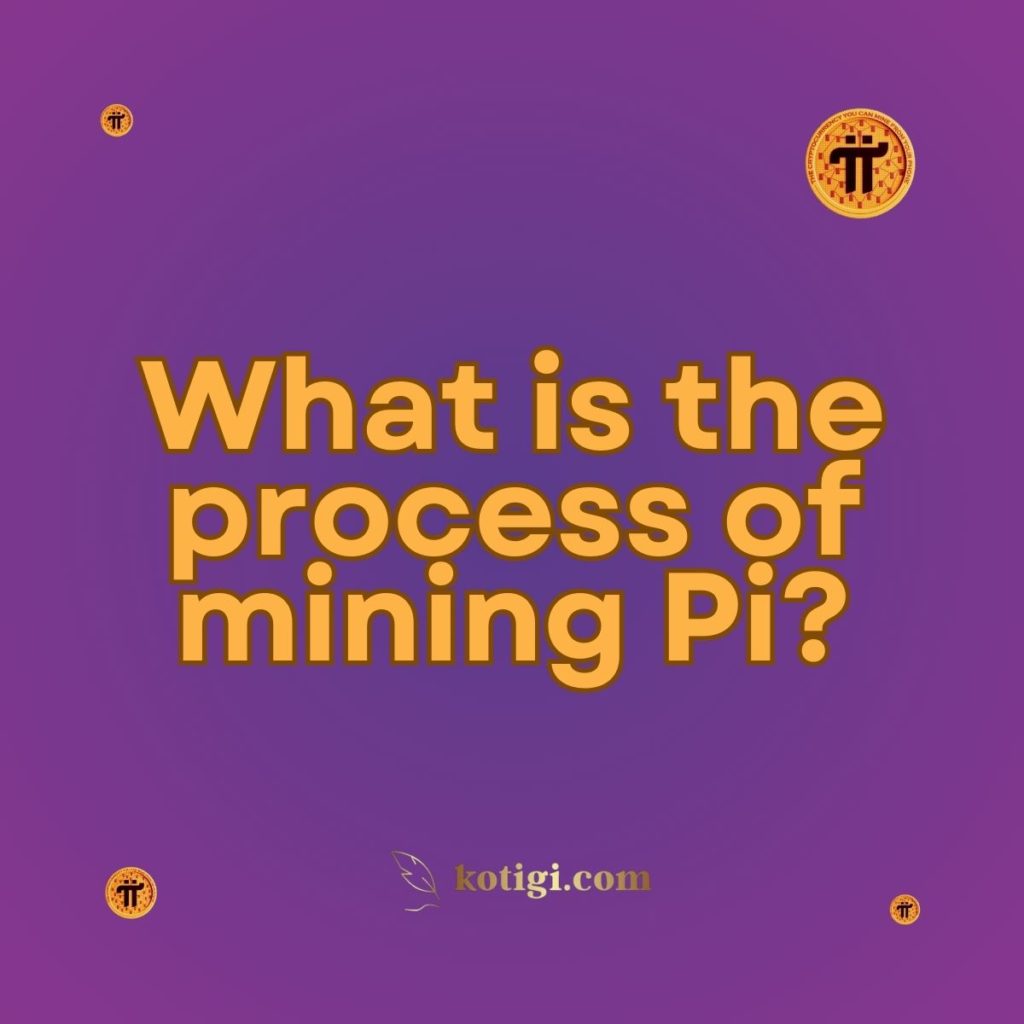
What is the process of mining Pi?
Mining Pi involves using a mobile device to participate in the Pi Network’s consensus algorithm. Unlike traditional cryptocurrency mining, Pi Network mining is energy-efficient, user-friendly, and does not require specialized hardware. Users contribute to the security and operation of the network by pressing a button daily to validate their participation.
Introduction
Pi Network is revolutionizing the world of cryptocurrency by making mining accessible to everyday users. Unlike Bitcoin or Ethereum, which require expensive hardware and substantial electricity, Pi Network enables mobile mining with minimal resources. In this blog, we’ll explore the mining process for Pi, how it differs from traditional methods, and how users can get involved.
Mining Pi is simple and energy-efficient, designed with user accessibility in mind. This post will explain the Pi mining process step by step, clarify the role of users in securing the network, and provide an overview of Pi’s unique consensus mechanism.
1. Understanding Pi Network Mining
1.1 What is Pi Mining?
Pi Network mining refers to the process of validating transactions and securing the network by contributing to its consensus algorithm. Unlike traditional mining methods, which rely on solving complex computational problems, Pi mining is based on participation.
1.2 Why Mobile Mining?
Pi Network’s goal is to democratize cryptocurrency access by enabling mobile mining. This removes the need for expensive hardware and high electricity consumption, which are typical barriers in conventional mining.
1.3 Decentralization Goals
Pi mining contributes to Pi Network’s decentralized vision. By allowing millions of users to participate via their smartphones, Pi Network distributes power and control more evenly than networks dominated by large mining farms.
2. The Role of the User in Pi Mining
2.1 Mining by Clicking a Button
Unlike Bitcoin miners who must solve complex cryptographic puzzles, Pi Network users simply need to open the app and click a button daily to participate in mining. This action demonstrates their ongoing activity on the network.
2.2 Daily Engagement
Pi Network requires users to open the app once every 24 hours to continue earning Pi. This process ensures ongoing participation without requiring continuous active computing.
2.3 Role of the Security Circle
Users play an essential role in Pi Network’s security through the creation of “security circles.” By adding trusted members to their circle, they help build a trust graph that secures the network from fraudulent activities.
2.4 How User Trust Affects Mining
The trust network, or security circles, indirectly influences the amount of Pi mined. Users with a robust and reliable security circle can earn additional rewards due to their contribution to the network’s integrity.
3. The Consensus Mechanism Behind Pi Mining
3.1 Stellar Consensus Protocol (SCP)
Pi Network’s mining system is powered by the Stellar Consensus Protocol (SCP), which is designed to achieve consensus in a decentralized environment. SCP allows Pi Network to reach agreement on transactions efficiently, without needing energy-intensive proof-of-work methods.
3.2 What Makes SCP Unique?
SCP is designed to function in a decentralized network where users are connected in a web of trusted relationships. This means that instead of relying on miners solving complex problems, the network reaches consensus through the trust established between users.
3.3 Pi Nodes and Validators
Although mining can be done on a mobile device, Pi Network also relies on nodes—computers that help validate transactions and secure the blockchain. These nodes are run by community members and use minimal resources compared to traditional blockchain networks.
3.4 Byzantine Fault Tolerance
Pi Network’s SCP is Byzantine Fault Tolerant, meaning it can continue to operate and reach consensus even if some network participants behave maliciously. This ensures the resilience and security of the network.
4. How Pi Mining Differs from Bitcoin and Ethereum
4.1 Energy Efficiency
Unlike Bitcoin and Ethereum mining, which require large amounts of electricity to power specialized hardware, Pi Network’s mobile mining process consumes negligible energy. Users can mine Pi on their phones without impacting battery life or performance.
4.2 Hardware Requirements
While Bitcoin mining necessitates high-end GPUs or ASICs, Pi Network’s mining process can be performed on any smartphone, making it more accessible to the general population.
4.3 Transaction Speed
Pi Network’s SCP allows for fast transaction processing, unlike Bitcoin and Ethereum, where mining can lead to slower transaction speeds due to network congestion.
4.4 Inclusive Mining
Pi Network enables anyone with a smartphone to mine, compared to Bitcoin and Ethereum, where mining is dominated by large, industrial-scale operations.
5. Phases of Pi Mining
5.1 Phase 1: Initial Distribution
Pi Network launched in 2019 with the goal of distributing Pi tokens through mobile mining. During this phase, the focus was on building a user base and establishing security circles.
5.2 Phase 2: Testnet
In Phase 2, Pi Network introduced a testnet environment where community members could run nodes and help test the blockchain’s functionality. This phase focused on improving scalability and decentralization.
5.3 Phase 3: Mainnet Launch
Phase 3 is the anticipated mainnet launch of Pi Network. Once the network fully transitions to the mainnet, Pi will become a tradeable asset, and the mining process will evolve to ensure that the network remains secure and decentralized.
5.4 Transition to Full Decentralization
As Pi Network grows, the aim is to transition to full decentralization, where all users have the opportunity to run nodes, vote on network decisions, and participate fully in governance.
6. Earning Rates and Halving in Pi Mining
6.1 How Mining Rates are Determined
The rate at which users earn Pi is based on a combination of factors, including the user’s activity, security circle contributions, and the overall size of the Pi Network user base.
6.2 Mining Rate Halving
To ensure scarcity and control inflation, Pi Network employs a halving mechanism similar to Bitcoin’s. As more users join the network, the rate at which Pi can be mined decreases, promoting long-term value.
6.3 Impact of User Growth on Mining
As the network expands, the rate of Pi mining slows, ensuring that early adopters are rewarded while maintaining incentives for new users to join.
6.4 Long-Term Sustainability
Pi Network’s halving model is designed to ensure the long-term sustainability of the currency. By gradually decreasing the mining rate, Pi becomes scarcer over time, increasing its potential value.
7. Running a Node in Pi Network
7.1 What is a Pi Node?
A Pi Node is a computer that helps verify transactions and maintain the integrity of the Pi blockchain. Running a node requires users to download Pi’s desktop software and participate in the validation process.
7.2 Requirements for Running a Node
Unlike Bitcoin, which requires powerful hardware to run a node, Pi Network nodes can run on standard consumer-grade computers. This makes running a node accessible to more users.
7.3 Benefits of Running a Node
Running a Pi node allows users to contribute to the decentralization and security of the network. Node operators may also receive additional Pi rewards for their contribution.
7.4 The Role of Nodes in Consensus
Pi nodes help the network reach consensus on transactions and ensure the validity of blocks added to the blockchain. They play a vital role in maintaining the decentralized nature of Pi Network.
8. The Future of Pi Mining
8.1 Mainnet Transition and Its Impact
With the anticipated mainnet launch, Pi mining will undergo significant changes. The network will transition from a mobile-first mining process to a more decentralized model involving nodes and validators.
8.2 Long-Term Mining Prospects
Pi Network plans to continue allowing users to earn Pi, but the methods and rewards may evolve. As the network matures, the focus will likely shift toward maintaining security and scalability.
8.3 Evolution of User Roles
In the future, users will have more opportunities to participate in governance, run nodes, and contribute to the network’s overall development. Mining will become just one of many ways to engage with Pi Network.
9. Potential Challenges in Pi Mining
9.1 User Engagement
One challenge Pi Network faces is maintaining user engagement. Since mining Pi requires minimal effort, some users may become complacent, leading to decreased activity.
9.2 Scalability Concerns
As Pi Network continues to grow, scalability will become a key issue. Ensuring that the network can handle millions of users without compromising performance will be critical.
9.3 Balancing Decentralization and Efficiency
Pi Network’s goal is to maintain decentralization while ensuring efficient operations. Striking this balance will be essential as the network transitions to mainnet.
Conclusion
Mining Pi is a simple, accessible process that allows users to participate in securing the network via their mobile phones. By leveraging the Stellar Consensus Protocol, Pi Network provides an energy-efficient alternative to traditional cryptocurrency mining. As the network transitions to mainnet and expands its decentralized operations, users will have more ways to contribute, such as running nodes and participating in governance. The future of Pi mining is poised to evolve with the growth of the network, ensuring both sustainability and user engagement.
Key Takeaways:
| Key Aspect | Description |
|---|---|
| Mobile Mining | Users mine Pi by pressing a button on their smartphone daily. |
| Stellar Consensus Protocol | Pi Network relies on SCP, ensuring energy efficiency and decentralized consensus. |
| Security Circles | Users build security circles, contributing to the network’s integrity. |
| Halving Model | The mining rate decreases over time, promoting long-term value and scarcity. |
| Node Participation | Running a Pi node allows users to help secure the network and validate transactions. |





